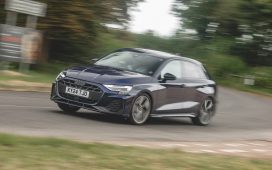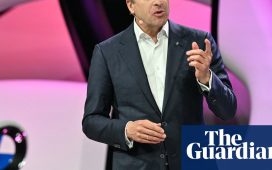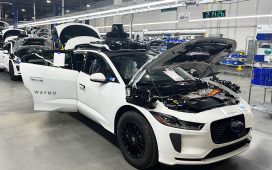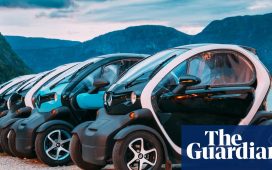The 2019 kickoff of Washington state’s hybrid-electric ferry program couldn’t have been more jubilant. Gov. Jay Inslee, standing inside Vigor Shipyards on Harbor Island, promised a green “revolution” that would begin right there, at the mouth of the Duwamish River, and cascade across industries around the globe.
By his side was Vigor’s then-CEO, Frank Foti, committing to building five new clean-running ferries by 2028, with the first rolling off the line by 2022. It would be a “great honor,” he said, and “totally in keeping with Vigor’s value of love.”
But 2½ years later, their partnership would fall apart, casting the grand plans for a reborn fleet into a state of uncertainty at a time when new boats are needed more than ever.
The result is a red sky in the morning for the fleet as the green and white totems of Puget Sound and the Pacific Northwest continue to degrade. Beyond the quest to green the heavily polluting vessels is the question of how well the country’s largest ferry system can deliver basic service for years to come.
Despite the backslapping and hyperbole of that September day, the two sides could not agree who would be liable for the boats’ performance and how much it should cost to build them, according to communications between state and Vigor officials obtained through a public records request.
Months later, under new ownership by one of the world’s largest private equity firms and flush with federal military contracts, Vigor expressed concern about accepting risk in its first contract to build the new hybrid-electric boats. Ultimately, Washington State Ferries cut off negotiations when Vigor said the first ferry would cost more than $400 million — more than double the state’s estimate.
Not only did the state not receive a boat in 2022, there is no builder in line. New projections peg a 2027 rollout for the first boat in the new hybrid-electric fleet, but prospective bidders have voiced skepticism about that timeline.
Few shipbuilders here have taken the lead on ferry construction, and there’s no obvious substitute for Vigor. The Legislature this year made it easier to contract with out-of-state builders but, with much of the industry residing in more conservative Gulf states, doing so could mean ignoring Washington’s environmental, labor and small business requirements, a frustrating prospect to in-state shipyards that are obligated to comply.
“Yeah, we’re screwed,” said Sen. Joe Nguyen, a Democrat whose West Seattle district includes Harbor Island. “We thought we had set up an infrastructure that would have made it work here in Washington state. We were not quite there.”
In the San Juan Islands, the Kitsap and Olympic peninsulas and Whidbey Island, ferries are the link to work, school, doctor visits, weddings, funerals and loved ones. The system is so critical to Pacific Northwest life and tourism, with nearly 17.5 million trips just last year, it is a part of the state highway network.
In early 2023, just nine of the state’s 21 ferries were considered in good shape. With vessels aging into their 40s and 50s — or, in the Tilikum’s case, 60s — the mechanical whack-a-mole has been building for years. Since 2017, the system has been averaging around 500 canceled trips a year due to unplanned maintenance, according to the state Department of Transportation. Between 2018 and 2022, the backlog of ferry preservation needs rose nearly 30%, from $209 million to $270 million. Three boats are nearly ready for retirement, but are being kept on life support to the tune of tens of millions of dollars a year.
“It’s a challenge keeping a vessel going for 60 years,” said Matthew von Ruden, director of vessels for WSF. “Not very many outfits can keep a vessel going at this level of operational tempo that we have.”
This year is on pace to be the worst yet. In the first three fiscal quarters of 2023, nearly 900 sailings were canceled because of problems with the boats. The most dramatic example was the ferry Walla Walla, which, after the gas was somehow contaminated, lost steering and beached on Bainbridge Island.
Daily notices from WSF show a ticker scroll of quieter failings, often described simply as “mechanical issues.”
The state’s current fleet of 21 boats leaves zero slack, particularly during peak season. Full service requires 19 boats running, with two out for routine maintenance at all times. Any time a boat fails, there is no extra to swap in.
After a decade of inertia in the early aughts — driven by a new cap on property taxes — there were signs the state had indeed gotten things going between 2011 and 2018, as four new vessels built by Vigor floated into service. So confident was the state that the momentum would carry forward with Vigor — and so unconfident someone else would step up — there was no bidding process for the next five ships. Instead, officials opted to extend the contract with Vigor to save time and money. If the two sides could agree on price, they believed, an environmentally friendly ferry would sail Puget Sound by 2022.
How we got here
On all 10 state ferries added since 1997, the primary builder was Vigor, formerly known as Todd Shipyard. While there was some competition in the prequalification stage of contracting, Vigor was ultimately the only bidder on seven of those ships. On the three prior, there was just one other.
There are dozens of shipyards in Washington, but when it came to taking the lead on ferry construction, none have the space or experience of Vigor.
A 2016 report commissioned by the Legislature named two other possibilities, Nichols Brothers and Dakota Creek, but ruled out the former for lack of capacity and the latter because it was not participating in the state’s mandatory apprenticeship program. Nichols Brothers and Dakota Creek have both built components of ferries, as well as passenger-only boats, but neither has taken the lead on a state ship capable of carrying cars, and industry experts doubt their capacity to take on such a large contract.
The situation has been growing precarious for years.
Of the roughly 20 different builders who have assembled a Washington state ferry in the last 100 years, nearly all have shut down, according to Shipbuildinghistory.com.
And yet, federal restrictions on international boat building, combined with state requirements for ferries to be built in Washington, meant the state couldn’t look elsewhere. By contrast, BC Ferries, in Canada, received 18 bids for its hybrid-electric Island Class vessels in 2019 — all from overseas.
The lack of bids spurred some, as early as 2013, to call on Washington to reconsider its in-state mandate. The state auditor’s office found the rule likely contributed to higher-cost boats. A 2016 report found the same.
Bob Pishue, who works on transportation policy for the conservative-leaning Washington Policy Center, wrote a memo in 2015 calling on lawmakers to roll back the requirement.
“When you put all your eggs in one basket, or pretty close to one basket, one point of failure poses a huge problem,” said Pishue.
Legislators tweaked the law in 2015, allowing work to go out of state if local builders came in 5% over the engineer’s estimate. But the state stuck with Vigor, the slightly higher cost seen as worth it to keep the work in state.
And after all, the relationship with Vigor was viewed as solid, curbing any urgency to deepen the well of possible builders. It was a family-owned business with a long history of ferry construction. What would disrupt that?
The price climbs
A month after Inslee’s triumphant news conference on Harbor Island, Vigor changed hands. The private equity company Carlyle Group announced in July 2019 it was buying the boat builder for an undisclosed amount.
Foti, Vigor’s longtime CEO whose family founded the company, stepped down, making way for Jim Marcotuli, whose resume is heavy with manufacturing, transportation and defense experience, including as CEO of gun and ammunition manufacturer Remington Outdoor Company.
Around that same time, Vigor’s portfolio of federal military contracts ballooned — $1 billion to build army landing craft; $254 million to refurbish the USS Chosin; $155 million to modernize the USS McCampbell; $131 million to overhaul the USS John Paul Jones, which can be seen sitting in one of Vigor’s dry-docks on Harbor Island at the southern end of Elliott Bay. In total, between 2017 and 2023, Vigor signed federal contracts that could be worth up to nearly $6 billion over their lifetime.
A contract for the new ferries, while sizable, was not key to the company’s success.
“You have a shipyard like Vigor, who has great [Department of Defense] contracts, Navy, Coast Guard and elsewise makes good money, great margins, especially in repair and maintenance — it makes it hard to fit in or even just have the space,” said Joshua Berger, founder of the nonprofit Maritime Blue.
State legislators, agency officials and industry experts saw the sale as a turning point.
“I don’t think they have the same engagement in the community, nor interest in Washington state, as the previous owners,” said Nguyen.
In a prepared statement, Vigor spokesperson Benton Strong said the company is committed to the “long and successful partnership serving Washington State Ferries. That commitment has not changed and we look forward to further opportunities which best fit Vigor” on behalf of its workers.
Vigor is still a player in Washington’s ferry system. The company last week won a contract to convert three existing ferries to hybrid electric. Because WSF has already done the design work, the project carries less risk for Vigor.
But where Foti was seen as willing to spend on potentially risky projects if he saw them as interesting or part of the company’s Northwest ethos, Marcotuli was viewed as less eager to expose the rest of Vigor’s considerable business to the economic and reputational risks that might come with taking on the challenge of new hybrid electric boats.
“They have stakeholders that they’re responsible to that are different than the stakeholders the prior ownership was responsible to,” said von Ruden.
So while the state hoped to simply extend the terms of the most recent contract, Vigor drew harder lines in its negotiations. The company demanded cost protections and a lower cap on liability, a change from previous agreements.
Rather than four diesel engines, the new boats are set to have just two, alongside two mega-batteries that could be recharged on shore while cars load and unload. When fully functional, the boats would use less than 10% the amount of diesel fuel and significantly reduce the greenhouse-gas emissions from the state’s most polluting agency.
Lawmakers and local maritime voices downplay the novelty of the technology; ferries in Norway and elsewhere in northern Europe already run similar boats.
But it would be a new front in the United States. Vigor said it demanded reduced liability because “risk of correcting defects on previous vessels is higher on [hybrid electric Olympic class ships] owing to novel hybrid technology.”
The state insisted Vigor write its perceived risk into its price. The company eventually obliged, tacking another $68 million onto the already high cost of the boat — bringing the total estimate to over $400 million, more than double the state’s $191 million estimate. The previous four boats, combined, cost just over $500 million to build, and legislators had budgeted around $1 billion for the next five.
Vigor’s demands and price angered lawmakers and WSF cut off negotiations.
Nguyen compared the company’s price to an unrealistic quote from a contractor who has plenty of other work. “It’s like, ‘a hundred grand to replace a toilet,’” he said. “OK, cool, that’s basically saying no. That’s how it felt.”
Looking elsewhere
The deal fell apart two weeks after the end of the 2022 legislative session. Lawmakers had just budgeted $1.3 billion for the five boats, plus three conversions and the electrification of terminals, but had not taken on the “build in Washington” mandate.
“I do believe that people felt there was a resolve” to reach an agreement with Vigor, said Rep. Andrew Barkis, R-Olympia.
Without a deal, the state was suddenly looking at a drawn-out rebid, a process made longer by the requirements that the work be offered to local builders first.
And so, after at least a decade of urging, the Legislature this year rolled back its in-state requirement, nearly unanimously. Local builders would get a slight preference — a 13% credit — but the next round of bidding would go national.
“We needed boats built yesterday,” said state Sen. Liz Lovelett, D-Anacortes. “And so messing around with the procurement process is the last thing anybody needs.”
The state could reissue its bid for the boats this fall. The best-case scenario for Lovelett and others is a partnership between a local builder and an out-of-state company.
Across the country, as in Washington, the number of shipyards has decreased. According to von Ruden, the state has heard interest from a few places, including San Diego and Wisconsin. But lawmakers view the Gulf Coast as the most likely place a ship could be built, particularly Louisiana, a “right to work” state that has 2½ times the number of private shipbuilding and repair jobs as Washington and where it’s assumed the price would be significantly lower.
“The highest density of shipbuilders, particularly shipbuilders that build vessels about the size of ferries, is in that Gulf region, because of the oil and gas industry,” said von Ruden.
Mike Faulk, spokesperson for Inslee, said in a statement the limited capacity among Washington boatbuilders has long been a concern. Still, he said, local yards “will be well-positioned to compete with other shipbuilders under this new statute.”
Gavin Higgins, CEO of Nichols Brothers, was doubtful.
“They won’t be forced to deal with the added expenses of the environmental management we have to do here,” he said of out-of-state yards. Nichols built the previous four “superstructures” for the ferries — most everything above the engines and hull — and the company has expressed interest in taking on a full project. But Higgins estimated Washington’s requirements add 20% to the cost.
Sen. Marko Liias, D-Everett, acknowledged the disconnect but said the state needs new boats more than it needs to comply with its own regulations.
“When in conflict, in this case, we’re going to focus on meeting that timeline and getting those boats in service as soon as possible,” he said.
A lifeline across the water
The very viability of the San Juan Island community is wrapped up in the ferries, and it’s lately become more difficult to know where it goes from here, said Anna Lisa Lindstrom.
The owner of Duck Soup Restaurant sees a perfect correlation between canceled trips and canceled reservations. Lack of housing on San Juan makes predictable sailing schedules more important, and without those there’s no one to bag groceries, serve tables, staff the local hospital or teach the children.
“A lot of people as they age here are leaving because the challenges to medical care are just too much,” she said.
Nathan Butler, head of the island’s EMS service, sees it, too.
Anyone who lives in the San Juan Islands accepts the uncertainty that comes with ferries, said Butler. But it’s worse now.
Daily, people are missing appointments, be it at the dentist’s office or the OB-GYN. One person he knows had a heart attack and has struggled to get to his follow-up visits in Anacortes.
All around the ferry system, retirements, resignations and firings have driven shortages and have meant certain routes — to Bremerton, Southworth, Coupeville — run on reduced service.
Staffing shortages are near universal in the maritime industry right now, and the state ferry system has ramped up efforts to recruit and train new workers.
But the state of Washington’s fleet is a local story whose ending still sits on a distant horizon. The 2040 goal is to add 16 new boats, at a cost of around $4 billion. Vigor’s proposal would have used up half that budget for five boats.
Matthew von Ruden, with WSF, is still hopeful the first ferry will be ready in 2027. But even last year, before the Legislature made changes to the bidding process, some in the local maritime industry told ferry officials the timeline was aggressive.
In response, WSF said it would “consider revision of production schedule targets.”









